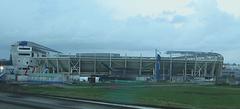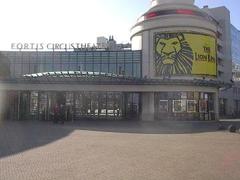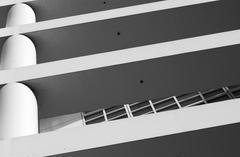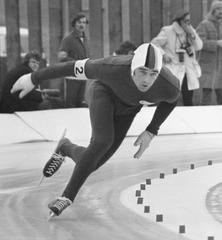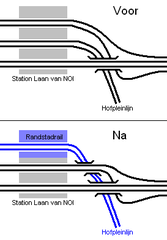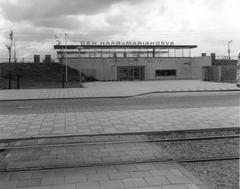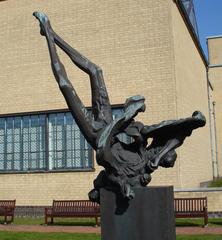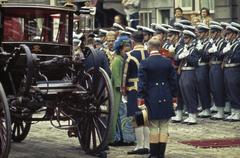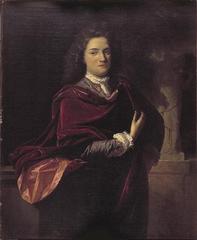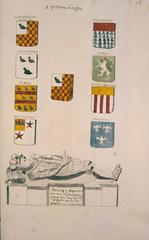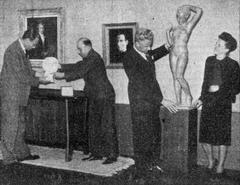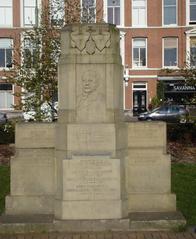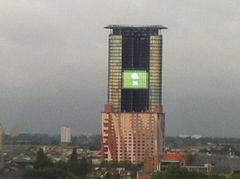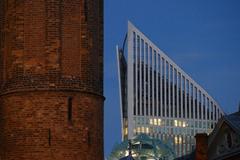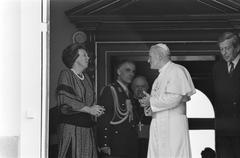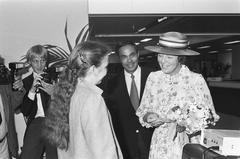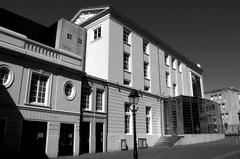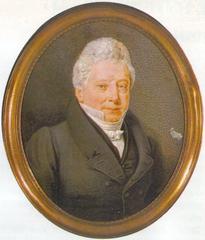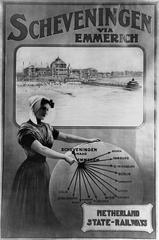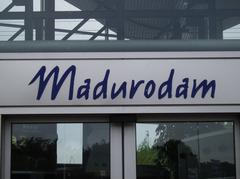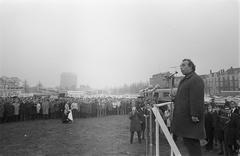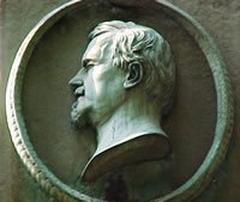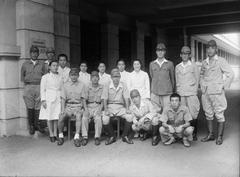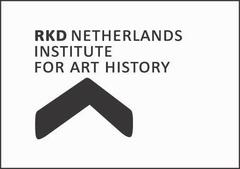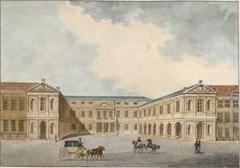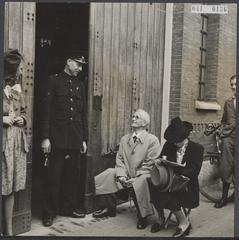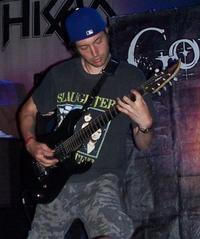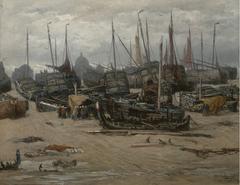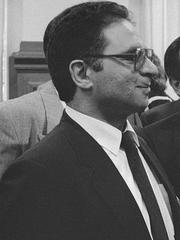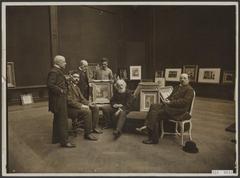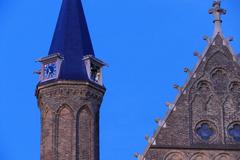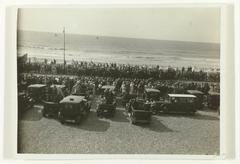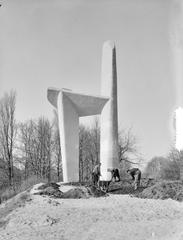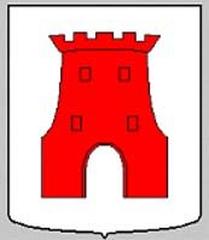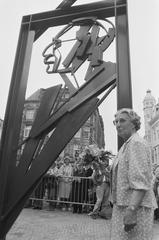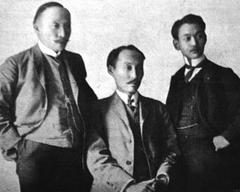
Beatrixkwartier Visiting Guide: The Hague Historical Sites, Tickets, and Hours
Date: 04/07/2025
Introduction
Beatrixkwartier, nestled in The Hague’s Bezuidenhout district, stands as a model of modern urban development, seamlessly integrating cutting-edge architecture, sustainable innovation, and international business activity. As The Hague’s second-largest office district, it hosts global players like Siemens Netherlands and Deloitte, alongside embassies and international organizations. The area’s evolution from industrial expansion to a thriving international business hub mirrors The Hague’s broader reputation as the “International City of Peace and Justice,” fusing economic dynamism with a commitment to sustainability and urban vibrancy (denhaag.nl, pingproperties.com).
Visitors to Beatrixkwartier can expect a district defined by innovative infrastructure, notably the Beatrixlaan RandstadRail station—famously known as the “Netkous”—an award-winning architectural feat by ZJA Zwarts & Jansma Architecten. The station, with its elevated glass-and-steel viaduct, not only offers efficient mobility but also transforms the neighborhood with multifunctional public spaces and green corridors (archello.com, zja.nl).
Increasingly, Beatrixkwartier is undergoing transformation into a mixed-use neighborhood, offering green spaces, cultural venues, and sustainable mobility—supported by extensive cycling lanes and electric vehicle infrastructure. Its accessibility, bolstered by proximity to Den Haag Centraal and Laan van NOI stations, ensures seamless connections for business travelers, architecture enthusiasts, and tourists alike (iss.nl, projecten.denhaag.nl).
This comprehensive guide presents Beatrixkwartier’s historical evolution, architectural icons, visitor information (including hours and ticketing), and practical travel advice. Whether your interests lie in business, urban innovation, or exploring The Hague’s unique blend of tradition and progress, Beatrixkwartier is a destination of choice (denhaag.nl, projecten.denhaag.nl).
Contents
- District Overview: History, Urban Development, and Significance
- Landmarks and Key Features
- Visitor Information: Hours, Tickets, and Accessibility
- Modern Architecture and Public Spaces
- Sustainability and Urban Transformation
- Frequently Asked Questions (FAQ)
- Visuals and Media
- Related Attractions and Articles
- Peace Palace Guide: Historical Context and Visitor Details
- Summary and Visitor Recommendations
- Sources
District Overview: History, Urban Development, and Significance
Historical Context
Beatrixkwartier’s story is deeply linked to The Hague’s transformation from a royal city to an international center. Bezuidenhout, the broader district, expanded during the Industrial Revolution, blending residential blocks with vital infrastructure (denhaag.nl, iss.nl). By the late 20th century, Beatrixkwartier emerged as an office and business hub, reflecting The Hague’s growing international stature.
Urban Development and Architectural Identity
Today, Beatrixkwartier is the Netherlands’ second-largest office district, with headquarters for Siemens Netherlands (in The Hague since 1879), Deloitte, and other major corporations (pingproperties.com). Modern high-rises dominate the skyline, many certified to LEED GOLD and BREEAM-NL standards.
The district’s strategic location between Den Haag Centraal and Laan van NOI, connected by the RandstadRail, ensures excellent accessibility (archdaily.com). The Beatrixlaan lightrail station, with its signature “Netkous” structure, is a symbol of innovative, sustainable design (archello.com). The municipality’s commitment to urban renewal is evident in upgraded public spaces, green corridors, and pedestrian and cyclist infrastructure (pingproperties.com).
Significance
Beatrixkwartier’s concentration of multinationals and international organizations underlines its economic and diplomatic importance (denhaag.nl). The district’s walkable layout, green mobility, and proximity to the International Zone (home of the Peace Palace) highlight its role as an inclusive, future-oriented urban center (archello.com).
Landmarks and Key Features
Beatrixlaan Lightrail Station (“Netkous”)
The Netkous is more than a transport node; its 400-meter-long, elevated steel lattice structure creates a dramatic visual identity and fosters new public spaces below. The design incorporates sound-absorbing foundations and is inspired by Buckminster Fuller’s principles and Chicago’s elevated trains (archello.com, zja.nl).
Office Complexes and Corporate Headquarters
Key buildings include Siemens’ Dutch headquarters and the Prinsenhof complex, both exemplifying sustainable, transparent design principles with energy-efficient façades and green roofs (pingproperties.com, dbpedia.org).
Public Spaces and Green Areas
Tree-lined walkways, open squares, and green patches near the station and offices offer spaces for relaxation and informal gatherings (archello.com). Plans for additional parks and revitalized public areas are ongoing (projecten.denhaag.nl).
Modern Architectural Highlights
- Nationale Nederlanden Tower: One of the tallest and most recognizable buildings.
- KPN, Siemens, and Deloitte Offices: Examples of sustainable and modernist design.
- ANWB Headquarters (Under Construction): A new addition, promising further architectural diversity and new public amenities.
Public Art and Installations
Contemporary public art, innovative benches, and landscaping animate the open spaces, providing visual interest and opportunities for social interaction.
Visitor Information: Hours, Tickets, and Accessibility
- District Hours: Beatrixkwartier is open to the public 24/7; there are no entry fees for public spaces or the lightrail station.
- Office Hours: Most office buildings are accessible Monday to Friday, 8:00 AM to 6:00 PM. Guided tours may be available by arrangement with specific companies or tour providers.
- Tickets: No general ticketing is required for visiting Beatrixkwartier. Special events or exhibitions may have separate entry requirements (projecten.denhaag.nl).
- Accessibility: The district is fully accessible, offering step-free routes, elevators at the Netkous station, and facilities for persons with reduced mobility.
- Transport: Easily accessible via Den Haag Centraal and Laan van NOI stations (RandstadRail, tram, and bus), as well as by bike (with ample paths) and car (limited parking in office complexes) (iss.nl).
- Amenities: Cafés, restaurants, shops (notably along Theresiastraat), and nearby green spaces like Haagse Bos are readily available for visitors.
Modern Architecture and Public Spaces
Beatrixkwartier’s urban fabric is characterized by:
- Sleek glass façades and open-plan offices that embody transparency and innovation.
- Public squares under the Netkous and around office towers, animated by events, food trucks, and pop-up markets.
- Green corridors and parks, with further expansion planned in the coming years (projecten.denhaag.nl).
- Cyclist and pedestrian infrastructure, connecting Beatrixkwartier to the wider city and supporting sustainable travel.
Sustainability and Urban Transformation
The Hague’s municipality actively drives Beatrixkwartier’s transformation into a climate-adaptive, mixed-use neighborhood:
- Residential Expansion: Projects like Monarch III offer modern, sustainable apartments.
- Public Space Revitalization: Ongoing efforts to develop parks, plazas, and recreational areas.
- Climate Initiatives: Programs such as “Klimaatdeal Vergroenen Haagse Netkous” focus on greening infrastructure and enhancing biodiversity.
- Sustainable Mobility: Robust cycling networks, electric vehicle charging, and integrated public transport (projecten.denhaag.nl).
Beatrixkwartier’s green ambitions are realized in both building design and public spaces, setting a benchmark for sustainable urban development (pingproperties.com).
Frequently Asked Questions (FAQ)
Q: Are there entrance fees for Beatrixkwartier?
A: No, the district and its public spaces are free and open to all.
Q: What are the best times to visit?
A: Weekdays (8:00 AM–6:00 PM) offer the energetic business atmosphere, but public spaces are accessible any time.
Q: Are guided tours available?
A: Some local operators and organizations offer guided tours focusing on architecture and sustainability; check with providers or the municipality.
Q: How do I get there?
A: Use the RandstadRail via Den Haag Centraal or Laan van NOI, or cycle along dedicated paths.
Q: Is Beatrixkwartier suitable for cyclists and pedestrians?
A: Yes, with extensive, safe paths and green spaces.
Visuals and Media
For immersive experiences, explore online virtual tours and photo galleries at the ZJA architects website and the municipality’s project page. All images feature descriptive alt text to enhance accessibility.
Related Attractions and Articles
- Discover The Hague’s Historic City Center
- Top Architectural Tours in The Netherlands
- Sustainable Urban Development in Dutch Cities
The Peace Palace: Historical Site and Visitor Guide
Introduction
The Peace Palace (Vredespaleis) is one of The Hague’s signature landmarks and a beacon of international law and diplomacy. Housing the International Court of Justice, the Permanent Court of Arbitration, and the renowned Peace Palace Library, it is central to The Hague’s international identity.
History and Cultural Significance
Built from 1907 to 1913 with funding from philanthropist Andrew Carnegie, the Peace Palace was designed by Louis M. Cordonnier in a blend of neo-Renaissance, Gothic, and Romanesque styles. It stands as a symbol of The Hague’s enduring role as a city of peace (peacepalace.org).
Visitor Information
- Hours: Open Tuesday–Sunday, 10:00 AM–5:00 PM; closed Mondays and public holidays.
- Tickets: Adults €12; discounts for students, seniors, and groups; children under 12 free.
- Tours: Guided tours (approx. 45 minutes) are available in English and Dutch, covering the Great Hall, library, and gardens.
- Accessibility: Fully accessible with ramps and elevators; assistance available.
Getting There
- By train: 20-minute walk or short tram ride from Den Haag Centraal.
- By tram: Lines 9 and 16.
- By bike: Secure bike parking nearby.
Nearby Attractions and Amenities
Visit nearby sites like Lange Voorhout park, Mauritshuis Museum, and the Binnenhof. Numerous cafés and restaurants serve the area (denhaag.com).
Special Events and Educational Programs
The Peace Palace hosts lectures, exhibitions, and educational group programs. Advance booking is recommended.
FAQ
Q: Are guided tours available?
A: Yes, in English and Dutch—booking in advance is recommended.
Q: Can I take photos inside?
A: Photography is allowed in designated areas; no flash or tripods.
Q: Can I visit the gardens separately?
A: Yes, during opening hours.
Q: Is it suitable for children?
A: Yes, children under 12 enter free, and tours are family-friendly.
Media
Useful Links
Summary and Visitor Recommendations
Beatrixkwartier stands as a testament to The Hague’s vision of urban development—where historic legacy meets modern architecture and sustainability. The district’s accessibility, award-winning infrastructure (notably the Netkous), and ongoing transformation into a mixed-use, eco-friendly neighborhood make it a model for contemporary city living (pingproperties.com, zja.nl, projecten.denhaag.nl, iss.nl).
With free access, excellent transport links, and proximity to major historical sites, Beatrixkwartier offers a rewarding experience for all visitors. Architecture lovers, urban explorers, and business travelers alike will find much to discover in this forward-thinking district.
Plan your visit today, stay updated via the official project page, and download the Audiala app for the latest tours and events.
Sources
- Ping Properties: Beatrixkwartier The Hague
- Municipality of The Hague: Beatrixkwartier Developments
- ISS International Institute of Social Studies: Hague Neighbourhoods
- Archello: Beatrixlaan Lightrail Station
- ZJA Zwarts & Jansma Architecten: Beatrixlaan
- The Hague: Short History
- The Hague Visitor Guides
- Peace Palace Official Site
- The Hague Historical Sites Guide
- Public Transport Information

